ABOUT THIS PUBLICATION
This publication presents the results of the Characteristics of Small Business Owners Survey which was conducted in June 2003 as a supplementary topic in the Australian Bureau of Statistics (ABS) monthly Labour Force Survey. This survey of households addressed a number of aspects of the operations of small business as well as identifying the characteristics of small business operators. The survey covers all private sector, non-agricultural small businesses. Similar surveys were previously conducted in February 1995, February 1997, November 1999 and June 2001. The ABS plans to conduct the next survey in June 2004 followed by an expanded version of the survey in June 2005.
COMMENTS ON THIS PUBLICATION
The ABS welcomes comments and suggestions from users on data items for future surveys. They should be addressed to the Director, Business Demography and Frames Section, Australian Bureau of Statistics, Locked Bag 10, Belconnen ACT 2616.
RELATED PUBLICATIONS
Other publications which may be of interest are:
- Small Business in Australia, 1999 (cat. no.1321.0) - biennial
- Small Business in Australia, 2001 (cat. no. 1321.0)
- Business Use of Information Technology, 2000-01 (cat. no. 8129.0) - annual.
UNPUBLISHED STATISTICS
More detailed small business statistics from the survey are available on request from the ABS. For example, many of the statistics presented here may be available by different cross classifications from the data presented in the publication.
ROUNDING
Where figures have been rounded discrepancies may occur between the sum of component items and the total.
INQUIRIES
For further information about these and related statistics, contact the National Information and Referral Service on 1300 135 070 or Murray Klee on Canberra (02) 6252 5452.
SUMMARY COMMENTARY
CHARACTERISTICS OF SMALL BUSINESS OPERATORS
This chapter presents information on Australian small business operators, including data on their age, sex, hours worked, and operators born in Australia and born overseas.
The term 'business operator' has been used to describe the person or persons who own and run the business. Generally these business operators can be identified as:
- the proprietor of a sole proprietorship
- the partners of a partnership
- the working director(s) of an incorporated company.
There is no standard definition of a small business operator and other ABS publications do not use the term, nor do they provide statistics about small business operators as a group. However, the expression 'small business operator' is one that is often used in research and policy debate and is generally taken to include the above group of people.
NUMBER OF OPERATORS
In June 2003 there were an estimated 1,591,500 business operators of the estimated 1,179,300 small businesses in Australia. Whereas, the annual average growth rate on the number of businesses was 0.7%, over the preceding two years the number of business operators declined, on average, 0.2%.
The contrasting growth rates between the number of operators and the number of small businesses (in table 3.2) is highlighted by the following:
- the rise in the proportion of small businesses with only one operator, an average annual increase of 2.4%
- the decline in the number of businesses with two operators, down by an average annual rate of 2.7%
- for businesses with three or more operators, an annual decrease of 2.0%.
SEX OF OPERATORS
Of the 1,591,500 small business operators, 1,063,000 (67%) were male and 528,600 (33%) were female at June 2003. The numbers for male and female operators remained consistent with the June 2001 survey findings.
Proportion of small business operators - June 2003
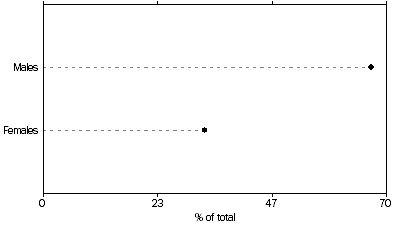 Average annual growth, Small business operators - June 2001 to June 2003
Average annual growth, Small business operators - June 2001 to June 2003
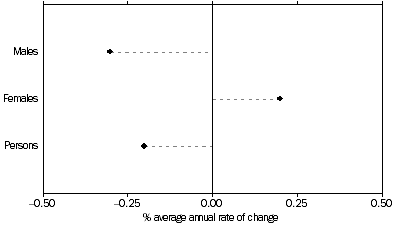
LOCATION OF OPERATORS
While the distribution of small business operators across states and territories generally reflected the population distribution, growth between June 2001 and June 2003 varied considerably between states. Victoria recorded the highest average annual growth rate of 3.1%. The results in Victoria were accentuated by the increase in female small business operators, where there was an average annual growth rate of 6.5%, more than five percentage points higher than the other states and territories. South Australia recorded the largest decrease in the number of operators down by 6.7%, with a 13% decrease in the number of female operators. Decreases were also recorded in the Australian Capital Territory (5.2%), the Northern Territory (3.0%) and Tasmania (2.7%).
AGE OF OPERATORS
Table 2.1 indicates that most small business operators (58%) were aged between 30 and 50 years. The distribution across age groups was as follows:
- 9.4% (149,600) were less than 30 years old
- 58% (917,300) were aged between 30 and 50 years
- 33% (524,600) were aged greater than 50 years.
The number of business operators aged greater than 50 years increased at an average annual rate of 3.7%. Those operators in age groups less than 30 years and those aged between 30 and 50 years recorded a decrease of an average annual rate of 6.2% and 1.2% respectively.
Proportion of small business operators - June 2003
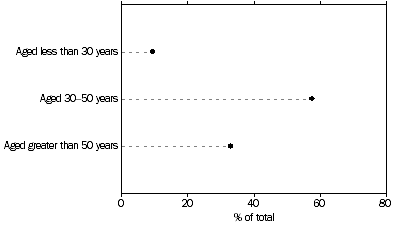 average annual growth, Small business operators - June 2001 to June 2003
average annual growth, Small business operators - June 2001 to June 2003
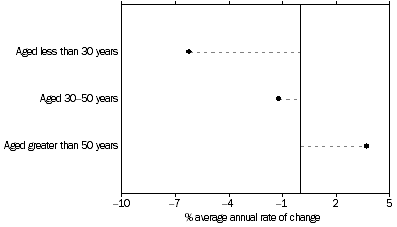
By sex
The distribution of small business operators by sex across the age groups at June 2003 was:
- for small business operators aged less than 30 years: 65% were male, 35% were female
- for small business operators aged between 30 years and 50 years: 65% were male, 35% were female
- for small business operators aged more than 50 years: 70% were male, 30% were female.
The number of male operators aged less than 30 years decreased by an average annual rate of 6.2%. However, for male operators aged greater than 50 years the average annual rate increased by 2.4%. This was also true for females, female operators aged less than 30 years had a negative growth rate of 6.1% and those aged greater than 50 years increased by an average annual rate of 6.9%.
By state and territory
In Victoria, growth in the number of small business operators was strongest, up by an average annual rate of 3.1% overall. This growth was underpinned by the group aged 30 to 50 years which grew, by an average annual rate of 4.6%. In Victoria, the average annual rate of growth for those operators aged less than 30 years recorded a slight decrease of 0.3%, since June 2001. There was a slight increase in the average annual rate for operators aged greater than 50 years (1.3%).
The average annual increase of female operators was highest in Victoria (6.5%). Female operators aged less than 30 years led this growth, up by an average annual rate of 23%. In contrast, South Australia recorded the largest average annual decrease of small business operators of all of the states and territories (6.7%). This average annual decrease was accentuated by the decrease in female operators (13%), a three percentage point greater decline than any other state or territory.
USUAL HOURS WORKED BY OPERATORS
Table 2.2 shows details of hours worked by small business operators for both full-time and part-time operators.
Full-time operators
Of the 1.6 million small business operators in Australia at June 2003, just under 1.1million (66%) were classified as full-time operators; that is, they usually worked 35 or more hours each week in the business. This proportion has declined from 70% in June 2001 to 66% in June 2003.
For all small business operators:
- 41% usually worked between 35 and 50 hours each week
- 22% usually worked between 51 and 75 hours per week
- 3.6% usually worked more than 75 hours a week.
The overall decrease in full-time operators is underscored by the 5.3 percentage point decrease in the proportion of operators working 35-50 hours between June 2001 and June 2003.
By sex
An estimated 857,600 (81%) of male small business operators worked full-time and 49% of these operators usually worked between 35 and 50 hours a week.
In contrast, only 38% of female small business operators worked full-time and 25% of these operators usually worked between 35 and 50 hours a week. The average annual growth rates for male and female operators who worked more than 75 hours a week were 8.7% and 13% respectively.
BY STATE AND TERRITORY
Across the states, New South Wales recorded the highest proportion of small business operators that were working full-time in their business, with 69% working more than 35 hours per week. Most other states recorded around 65% of operators working full-time, with the exception of Western Australia (62%). The Northern Territory recorded the highest incidence of full-time operators at 76%. The Australian Capital Territory recorded the lowest proportion of full-time operators with 59%.
A similar distribution across the usual hours worked categories was recorded in each of the states and territories. The Northern Territory recorded the highest proportion (9.3%) of all operators in the more than 75 hours usually worked category, as well as the highest proportion (31%) of all operators usually working between 51 and 75 hours per week. South Australia recorded the highest proportion (45%) of all operators usually working between 35 and 50 hours per week.
Part-time operators
Part-time operators, those who usually worked less than 35 hours a week in their business, constituted 535,000 (34%) of the 1.6 million small business operators in Australia at June 2003. Since June 2001 the proportion of part-time operators has increased from 29% to 34%.
In June 2003 there were 329,600 female small business operators working part-time, an average annual increase of 3.7% over the 2001 level of 306,800. The proportion of female part-time operators to total part-time operators increased to 62% in 2003 from 58% in 2001. The number of male small business operators working part-time increased by an average annual rate of 12%,
OPERATORS BORN IN AUSTRALIA OR BORN OVERSEAS
Table 2.3 shows details of operators born in Australia and those born overseas. In June 2003 an estimated 468,100 (29%) of small business operators were born overseas. This was consistent with the results recorded in June 2001.
By sex
An estimated 325,200 (31%) male small business operators were born overseas compared to 143,000 (27%) females. Over the period June 2001 to June 2003 the number of overseas born females increased by an average annual rate of 2.1%. The number of male small business operators born overseas was similar to the June 2001 results, with a slight decline of 0.3% in the average annual rate.
By state and territory
The state with the highest proportion of small business operators who were born overseas was Western Australia (39%). The proportion of overseas born operators in Western Australia increased to 39% in June 2003 from 37% in June 2001. New South Wales (33%) had the second highest proportion of small business operators born overseas, which was consistent with the June 2001 survey findings. Tasmania with 13% of small business operators born overseas, recorded the lowest proportion. The proportion of operators born overseas in Queensland remained steady at 24%. In contrast the Northern Territory recorded the greatest average annual rate of decrease (25%) of all the states and territories, from 33% in June 2001 to 19% in June 2003. This was followed by Tasmania where the proportion decreased from 18% in 2001 to 13% in 2003.
NUMBER OF BUSINESSES OPERATED
Table 2.4 provides data on the number of businesses owned by small business operators at June 2003, classified by the sex of operators and the number of businesses operated. Most operators (93%) were involved in just the one business; a further 5.3% were involved in two businesses and 1.9% were involved in three or more businesses.
By sex
Both male and female operators recorded similar figures as multiple business operators, with 7.4% and 6.9% respectively, involved in more than one business.
By state and territory
The proportions of operators involved in only one business were similar across all states and territories (between 91% and 94%).
CHARACTERISTICS OF SMALL BUSINESS
This chapter presents selected characteristics of small businesses including details of the ownership structure, business age, the use of computers and Internet access. Data are classified both by state/territory and business size.
Where comparable, estimates of businesses from the June 2001 and June 2003 surveys are presented in the tables, together with the average annual rate of change to assist analysis.
NUMBER OF BUSINESSES
There were an estimated 1,179,300 small businesses operating in Australia in June 2003. This represented a slight average annual increase of 0.7% since June 2001.
Of these:
- 666,200 (56%) were non-employing businesses, up by an average annual rate of 2.2% since June 2001
- 389,100 (33%) employed 1-4 people, down by an average annual rate of 1.1% since June 2001
- 124,000 (11%) employed 5-19 people, down by an average annual rate of 1.2% since June 2001.
Average annual growth, Small businesses - June 2001 to June 2003
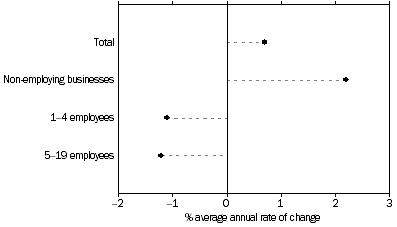
LOCATION OF OPERATION
Small businesses were distributed across states and territories in a similar proportion to small business operators, reflecting the general population distribution within Australia. The strongest average annual growth over the period June 2001 to June 2003 was recorded in Victoria (4.3%), followed by Western Australia (2.8%) and the Northern Territory (2.6%); New South Wales, Queensland and Tasmania recorded similar levels to the June 2001 survey. South Australia and the Australian Capital Territory recorded decreases, down average annual rates of 5.5% and 6.6% respectively.
In the Northern Territory the growth was strongest in non-employing businesses, at an average annual rate of 25%, though in absolute terms this was an increase of only 1,900 businesses. In Victoria, growth was strongest for businesses employing 5-19 people, with an average annual growth rate of 7.8%. Victoria also grew strongly in the non-employing businesses category with an average annual rate of 5.0%. Not all states recorded growth in non-employing businesses, there was an average annual rate of decline of 6.7% in South Australia; 4.3% in the Australian Capital Territory and 0.4% in Queensland.
LENGTH OF OPERATION
Table 3.1 also provides details of the length of operation of small businesses. Length of operation refers to the length of time the business has been operated by the current owner. Where an established business has been taken over, the operations of the previous owner have not been taken into account.
Of the 1,179,300 small businesses operating in Australia at June 2003:
- 152,700 (13%) had been in operation for less than one year, down by an average annual rate of 2.2% from June 2001
- 398,500 (34%) had been in operation for one year but less than five years, down by an average annual rate of 1.4% from June 2001
- 239,200 (20%) had been in operation for five years but less than 10 years, up by an average annual rate of 3.9% from June 2001
- 388,900 (33%) had been in operation for 10 or more years, up by an average annual rate of 2.3% from June 2001.
By size of business
For non-employing businesses, the highest proportion (37%) were aged one to less than five years. For businesses employing 1-4 people, the highest proportion was 38% for businesses aged 10 or more years. In the larger size group (businesses employing 5-19 people), businesses were more likely to be older, with 49% of businesses falling into the 10 or more years category.
Across the different business size groups, the most significant positive growth in the number of businesses over the period June 2001 to June 2003 occurred in the older business category, particularly those in the five to less than 10 years category. There was an average annual increase of 6.2% in the number of non-employing businesses aged five to less than 10 years, 1.7% in the number of 1-4 employing businesses; and 1.4% in the number of 5-19 employing businesses.
Decreases were recorded in the less than one year category in all size groups. Tasmania reported the largest decrease in the less than one year category for non-employing businesses, with an average annual rate of decline of 25%.
OPERATORS PER BUSINESS
In June 2003, there were 808,300 (69%) small businesses operating as single operator businesses. This represented an average annual increase in single operator businesses of 2.4% since June 2001. The numbers of businesses with two operators, and three or more operators decreased by an average annual rate of 2.7% and 2.0% respectively over the same period.
By size of business
Table 3.2 shows that:
For non-employing businesses:
- 81% had one operator (compared to 78% in June 2001)
- 18% had two operators (compared to 21% in June 2001)
- 0.8% had three or more operators (which is consistent with the June 2001 survey results).
For businesses employing 1-4 people:
- 58% had one operator (which is consistent with the June 2001 survey results)
- 39% had two operators (compared to 40% in June 2001)
- 2.2% had three or more operators (compared to 2.1% in June 2001).
For businesses employing 5-19 people:
- 34% had one operator (compared to 32% in June 2001)
- 55% had two operators (compared to 56% in June 2001)
- 12% had three or more operators (which is consistent with the June 2001 survey results).
By state and territory
There was little variation across states and territories with the Northern Territory (78%), New South Wales, Victoria and South Australia (70%) recording the highest proportion of small businesses with one operator. For small businesses with three or more operators, the highest proportions were recorded in Queensland (3.0%) and the lowest in the Northern Territory (1.2%).
PREDOMINANT SEX OF OPERATORS
Of the 1,179,300 small businesses in Australia in June 2003, 649,600 (55%) were operated by an individual male or predominantly by males. This represented an average annual increase of 1.4% since June 2001.
There were 299,600 businesses (25%), operated by equal numbers of males and females. The number of businesses in this group declined, down an average annual rate of 3.9%, from the 324,600 businesses recorded in June 2001, reversing the average annual increase of 6.2% over the 1999 data.
There was a further 230,200 businesses (20%) operated predominantly by females, up from 205,900 businesses in June 2001, an average annual growth of 5.7%.
By size of business
The non-employing business category was the most common business size group for both predominantly male operated businesses (59%) and predominantly female operated businesses (75%). The number of predominantly female operated non-employing businesses recorded an average annual growth rate of 9.9%, which was much higher than the growth rate for non-employing businesses predominantly operated by males, which had an average rate of growth (1.3%).
Businesses operated by equal number of male and female operators were more evenly spread across the three business size categories:
- 109,300 (37%) of businesses were non-employing businesses, down by an average annual rate of 4.6%
- 136,000 (45%) of businesses were employing 1-4 people, down by an average annual rate of 2.7%
- 54,300 (18%) of businesses were employing 5-19 people, down by an average annual rate of 5.6%.
USE OF COMPUTERS AND THE INTERNET
In June 2003, 846,500 (72%) of the 1,179,300 small businesses reported they were using computers in their business operations. As the size of the business increases, the likelihood that a business uses a computer increases, with 94% of businesses with 5-19 employees using a computer, compared to 62% of non-employing businesses. The figures for all business sizes has increased since June 2001, the overall average annual rate of growth is 4.6%.
When comparing these results to that of other ABS series, it should be noted that some series only measure the use of computers and the Internet by employing businesses.
Use of computers
Table 3.4 shows that between June 2001 and June 2003, there was a strong growth in the number of businesses using computers:
- 412,000 (62%) of non-employing businesses had a computer, up from 354,400 (56%) in June 2001
- 318,100 (82%) of businesses employing 1-4 people had a computer, up from 306,700 (77%) in June 2001
- 116,400 (94%) of businesses employing 5-19 people had a computer, up from 112,300 (89%) in June 2001.
Businesses that had access to the Internet increased to 727,700 businesses (62%) an average annual growth rate of 9.2%. Again the use of the Internet was more common in the larger businesses:
- 343,400 (52%) of non-employing businesses had access to the Internet, up from 271,500 (43%) in June 2001
- 278,200 (72%) of businesses employing 1-4 people had access to the Internet, up from 245,600 (62%) in June 2001
- 106,100 (86%) of businesses employing 5-19 people had access to the Internet, up from 92,900 (73%) in June 2001.
Use of computers and the Internet - June 2003
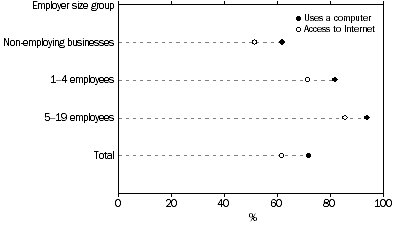
Use of Internet
The major uses of the Internet for small business operators include E-mail (52%), Research (48%), Making or receiving payments (29%) and 'Other' (53%). The 'Other' category can encompass a wide range of Internet related activities and this may contribute to the high response rate in this category.
It should be noted that 'making and receiving payments' is not a measure of E-commerce or I-commerce, as these are defined as ordering goods and services electronically or via the Internet, not on the method of making/receiving payments.
Between June 2001 and June 2003 use of the Internet by non-employing small businesses reported increases across the various uses as well as an overall average annual rate of increase of 2.2%. Proportionally, employing businesses made greater use of the Internet than did non-employing businesses, but the rate of growth in the two year period to June 2003 was greatest amongst non-employers.
More than half (52%) of small businesses used the Internet for e-mail, at June 2003 there was an average annual increase of 9.5%. Making or receiving payments increased significantly (an average annual rate of increase of 28% during the period June 2001 and June 2003). Almost 30% of all small businesses were using the Internet for this purpose, at June 2003, with non-employing small businesses significantly increasing their usage (an average annual rate of increase of 35%).
At June 2003, there were some 29% (up from only 18% of small businesses in June 2001) involved in 'making or receiving payments' via the Internet. Increasing use of the Internet for 'making and receiving payments' is reported across all small business sizes:
- 21% (139,800) of non-employing businesses used the Internet for 'making and receiving payments', up from 12% (76,300) in June 2001
- 36% (140,200) of businesses employing 1-4 people used the Internet for 'making and receiving payments', up from 22% (86,800) in June 2001
- 53% (65,600) of businesses employing 5-19 people used the Internet for 'making and receiving payments', up from 37% (47,100) in June 2001.
Uses of the Internet by small businesses - June 2003
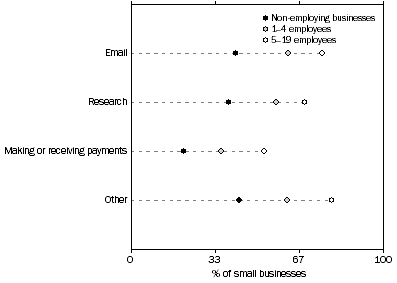
By state and territory
The proportion of small businesses using computers in their business operations was relatively consistent (70%-75%) across most states and territories. The Australian Capital Territory recorded the highest proportion with 75% of small businesses using computers. The Northern Territory, where 60% of small businesses were using computers, was more than 10 percentage points lower than any other state or territory.
Access to the Internet across states and territories followed a similar pattern to computer usage with levels highest in the Australian Capital Territory (68%) and lowest in Tasmania and the Northern Territory (both 57%).
HOME BASED SMALL BUSINESS
Home based businesses have been identified based on two definitions:
- where most of the work of the business was carried out at the home(s) of the operator(s) - these businesses are referred to as 'Businesses operated at home'
- where the business has no other premises owned or rented other than the home(s) of the operator(s) - these businesses are referred to as 'Businesses operated from home'.
- When combining figures for the two groups it should be noted that some overlap does occur.
In the first edition of this publication (1995), businesses were considered home based if 'one or more of the operators of the business worked more hours at home than away from home'. This definition is similar to the category 'Businesses operated at home' (as defined above), but is not strictly comparable.
NUMBER OF HOME BASED BUSINESSES
Home based businesses make up a very large proportion of the total small business population in Australia. At June 2003, there were an estimated 784,800 home based small businesses which were either operated from home or operated at home. This represented 67% of all small businesses. These businesses were operated by 987,700 people, representing 62% of all small business operators. Since June 2001, the number of home based businesses has increased at an average annual rate of 0.4% while the number of operators involved decreased at an average annual rate of 0.6% over the same period. These rates compare with an average annual growth rate of 0.7% for small businesses in general and an average annual decline rate of 0.2% for small business operators overall.
At June 2003, 95% (748,200) of all home based small businesses were operated from home. This represented a small average annual increase of 0.3% since June 2001. These businesses involved 935,100 operators, down by an average annual rate of 0.5% since 2001.
In June 2003, there were 280,600 small businesses (36%) operated at home, involving 360,100 operators. For this category growth was stronger, with the number of businesses increasing at an average annual rate of 2.7% and the number of operators increasing at an average annual rate of 1.0% over the two year period.
As mentioned above, overlap can occur between the 'operated at home' and 'operated from home' definitions as businesses can operate without premises and also have most of the work carried out at the home of the operators. In June 2003 there were 244,000 of these businesses involving 307,500 operators.
HOME BASED SMALL BUSINESSES |
|  |
 | Number of businesses | Number of operators |  |
 | '000 | '000 |  |
|  |
| Operated from home | 748.2 | 935.1 |  |
| Operated at home | 280.6 | 360.1 |  |
| Operated both from home and at home | 244.0 | 307.5 |  |
| Total home based, operating either from home or at home | 784.8 | 987.7 |  |
| Total home based and non-home based businesses | 1,179.3 | 1,591.5 |  |
|  |
OPERATORS OF HOME BASED BUSINESSES
By sex
At June 2003, across all home based small businesses, 669,600 (68%) operators were male. This represented an average annual decrease of 0.9% over the two years since June 2001. There were 318,100 female operators of home based businesses which represented an average annual increase of 0.1% over the same period. Males were less dominant in the 'operated at home' category, where they made up 54% of all such operators. This compared to the 'operated from home' category, for which 68% of such operators were male.
By age
The age distribution of home based small business operators was very similar to the overall distribution for small businesses with 11% aged less than 30 years; 57% aged between 30 and 50 years; and 33% more than 50 years old.
By hours worked
Home based operators were more likely to be working part time than all small business operators, with 41% usually working less than 35 hours per week. This compares with 34% for all small business operators. Female home based business operators in particular were more likely to work part time in their business than those in all small businesses, with 73% working less than 35 hours compared to 62% overall. For male home based business operators, only 26% were working part time compared to 19% overall.
Born in Australia or born overseas
The proportion of home based small business operators who were born overseas was 29%, the same proportion recorded for all small business operators.
Number of businesses operated
At June 2003, 94% of home based business operators operated just the one business; this compared with 93% across all small businesses.
By state and territory
Home based small business operators were distributed across states and territories in a similar proportion to small business operators overall, with both reflecting the general population distribution within Australia.
In terms of change since June 2001, the strongest growth in the number of home based business operators was recorded in Western Australia with an average annual increase of 5.2%, and Victoria with an average annual increase of 2.0%. At the other end of the scale, the greatest declines in the number of home based business operators were in the Australian Capital Territory and the Northern Territory, which recorded average annual decline rates of 11% and 6.5% respectively. South Australia reported an average annual decline rate of 5.8%.
CHARACTERISTICS OF HOME BASED BUSINESSES
Table 4.3 shows a range of characteristics of home based small businesses. Of the 784,800 home based small businesses operating at June 2003 most (70%) were non-employing businesses. There were 214,500 (27%) home based businesses employing 1-4 people and 20,000 (2.5%) employing 5-19 people.
In terms of age of business, home based businesses followed a similar distribution pattern to that of total small businesses with:
- 15% aged less than one year old
- 35% aged one year to less than five years
- 20% aged five years to less than 10 years
- 30% aged 10 years or more.
Operators per business
In June 2003, 76% of home based small businesses were single operator businesses. This proportion was higher than that recorded for small businesses overall where 69% were single operator businesses. Conversely, there was a lower proportion of multi-operator home based small businesses, with 24% of home based small businesses having two operators, compared to 29% of small businesses overall, and 1.0% having three or more operators, compared to 2.4% overall.
Predominant gender of operators
Most home based businesses (58%) were operated predominantly by males, which is consistent with the figure recorded in June 2001. The number of home based businesses operated predominantly by females increased from 19% in June 2001 to 21% by June 2003. The proportion of businesses operated by equal numbers of males and females decreased to 21% in June 2003, an average annual decrease of 5.0%.
Use of computers and the Internet
At June 2003, 529,600 (68%) of Australia's home based businesses were using computers in their business operations. This was slightly below the proportion recorded for all small businesses (72%). In addition, 460,500 (59%) businesses had access to the Internet; this is marginally below the proportion for all small businesses (62%). The most common use being made of the Internet was for e-mail and other purposes (49% of home based small businesses). In addition, 45% were using the Internet for research purposes; and 26% were involved in 'making or receiving payments' via the Internet. Use of the Internet for this latter purpose increased at an average annual rate of 29% between June 2001 and June 2003.
 Print Page
Print Page
 Print All
Print All